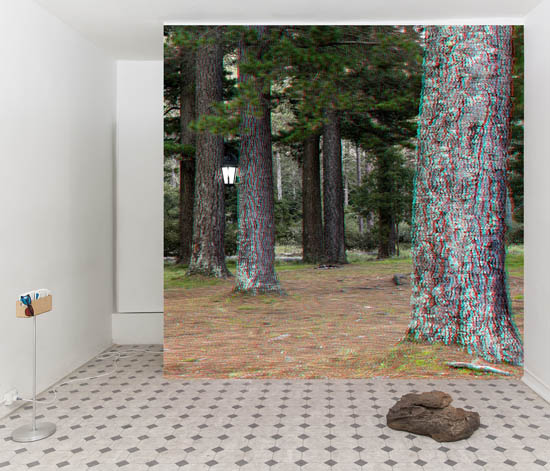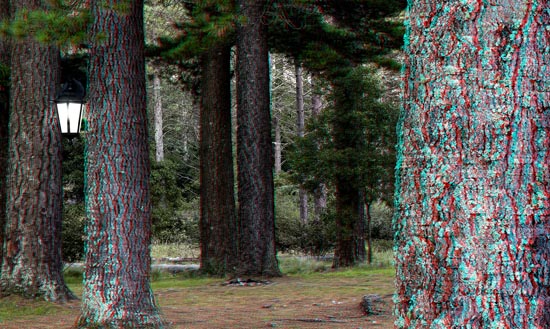Isobel Philip takes a walk through an enchanted forest…
The Good Forest, Geoff Kleem’s recent show at the Institute of Contemporary Art Newtown (I.C.A.N.), lured viewers into an immersive image space. The installation piece assembled in the small gallery was sparsely furnished; a stereoscopic photograph of a forest covered the back wall, an old fashioned street lamp protruded from the image and a rock sat on the floor in front of it. On entering the gallery, viewers took a pair of the 3D glasses provided and were absorbed into Kleem’s playful study of dimensional slippage.
The conflation of image space and object space that accompanies the 3D viewing experience is nothing new. In the age of the 3D movie blockbuster, we are increasingly acclimatized to the virtual tangibility of the stereoscopic image. We’ve felt its touch before. Yet, to discuss Kleem’s work in terms of the seduction of haptic tactility and the pull of illusion slightly misses the mark. Kleem does not simply play into the fetishization of the 3D image, indulging our infatuation with optical trickery, but complicates the logic of the 3D world. He dramatizes the interplay between image and object, exaggerating the discrepancy between flatness and depth as he exposes the gap between the real and the virtual like a magician revealing his secrets.
In The Good Forest, the feigned three-dimensionality of the image collided with the concrete three-dimensionality of the rock and the lamp. Seen through 3D glasses, Kleem’s installation violated exact linear perspective. The tree trunks in the foreground lunged toward the viewer while the lamp fixed to the wall receded; the image surged forward while the object withdrew. The flat and the solid changed places.
For Kleem, the stereoscopic image is not an aesthetic novelty but a means of expanding and contracting space. This push and pull — a perversion of spatial boundaries — is what made the work engaging. When visitors put on the 3D glasses and looked at the installation through new eyes, the structure morphed and mutated right in front of them. As image and object began their game of musical chairs, spatial categories became flexible.
And yet, something must also be said for the delicate absurdity of this set up. What is a street lamp doing in a forest? Who’s path is it lighting?
A forest is a metaphorically charged landscape. The archetypal setting of so many nightmares, it accommodates an ensemble cast of folkloric villains like the cannibalistic witch in Hansel and Gretal and the wolf in Little Red Riding Hood. The forest is a repository of the unknown — fear festers in the undergrowth. But light shatters this literary trope. To illuminate the forest is to cut through the darkness and disperse the sinister activity it preempts. Perhaps this explains the title of Kleem’s work. Wolves don’t hide in good forests.
A well-lit forest is a transformed and altered space. Light interrupts darkness and signals the arrival of an entirely different symbolic code. Good trumps bad. Kleem’s forest is a morphological construction. Like the enchanted forests found in mythology and folklore, it is an agent of transformation. Darkness is illuminated, the good eclipses the bad, and image and object fold into one another. It is this last metamorphosis — this last slippage — that binds the work together. As image and object change places, a dimensional interstice is unearthed. A porous membrane between the 2D and the 3D, this interstice mediated the viewer’s interaction with the work. It forged a pathway through the forest.
Pics: Geoff Kleem, The Good Forest (installation view: Institute of Contemporary Art Newtown (I.C.A.N.), Sydney), 2013, stereo anaglyph image, adhesive inkjet print/ Image courtesy the artist.


